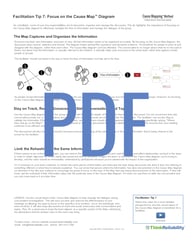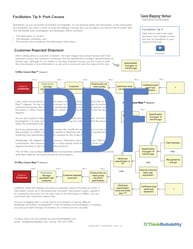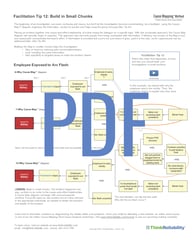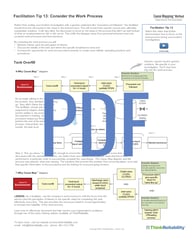Join us for the next Cause Mapping Root Cause Analysis Public Workshop ONLINE on December 16-18, 2025.
.jpg)
Facilitation Tips Resource Center
When facilitating an investigation, keep in mind that people naturally see things differently. Everyone has unique experiences that make them who they are. The different points of view are helpful when soliciting ideas on how to solve a problem, but it can be challenging in the analysis step. The Cause Mapping® method accommodates different viewpoints well. When facilitating an investigation, if someone sees it differently write the information down on the Cause Map™ diagram. The evidence will flush out what we can be certain of and what is in question.
Our facilitation tips posted so far are:
Tip 2: Be Specific When Phrasing Causes
Tip 5: Avoid Using Names During the Investigation
Tip 6: Utilize the Question Mark
Tip 7: Focus on the Cause Map Diagram
Tip 8: Encourage Everyone to Contribute Causes
Tip 11: Use the Phrase, "One of the Causes"
Tip 13: Consider the Work Process
Tip 16: Validate Cause-and-Effect Relationships
Tip 17: Don't Let Space or Tools Limit Your Investigation
Tip 19: Reveal Additional Causes
Tip 20: Let the Incident Determine Structure, Not the Method
Scroll down to see the full explanation of the tips we've posted so far, and check back every Friday as we continue to add to our list of tips for effective facilitators.
Tip 1: Slow Down

Take smaller steps between cause-and-effect relationships. Since solutions control specific causes on the Cause Map diagram, the more causes that are identified, the larger the solution set.
In this example, ThinkReliability instructor and facilitator Renata Martinez illustrates the value of slowing down during an analysis, using the transmission and infection of COVID-19 as an example. Watch the video below for her full explanation.
Click on the thumbnail to the right to download the PDF.
Tip 2: Be Specific When Phrasing Causes
 In this week's facilitation tip, Renata explains how the vague phrasing of causes may create unnecessary debates about where a cause fits on the Cause Map™ diagram. This situation may arise because wording isn't specific enough to fully capture each individual's point of view.
In this week's facilitation tip, Renata explains how the vague phrasing of causes may create unnecessary debates about where a cause fits on the Cause Map™ diagram. This situation may arise because wording isn't specific enough to fully capture each individual's point of view.
See her video below for a full explanation of the tip, and download the PDF to the left for the accompanying handout.
Tip 3: Avoid Generalizations
 Human error. Procedure not followed. Training inadequate. What do these terms all have in common? They artificially stop your incident investigation and inadvertently limit effective solutions. In this week's facilitation tip, Renata explains how moving past categorizations of problems like these can help you uncover specific organizational breakdowns and reveal sustainable, actionable solutions.
Human error. Procedure not followed. Training inadequate. What do these terms all have in common? They artificially stop your incident investigation and inadvertently limit effective solutions. In this week's facilitation tip, Renata explains how moving past categorizations of problems like these can help you uncover specific organizational breakdowns and reveal sustainable, actionable solutions.
Watch the video below for the full explanation of the tip, and download the PDF on the right for the handout.
Tip 4: Quantify the Causes
 When you start to hear phrases such as "too many," "too much," "not enough" or "excessive," use it as a signal to quantify the amount. These terms are subjective and can cause unnecessary debates. By quantifying the causes, your investigation findings will represent facts rather than personal perspectives or opinions. It will also help you to:
When you start to hear phrases such as "too many," "too much," "not enough" or "excessive," use it as a signal to quantify the amount. These terms are subjective and can cause unnecessary debates. By quantifying the causes, your investigation findings will represent facts rather than personal perspectives or opinions. It will also help you to:
- Promote discussion and engagement during your investigations
- Reduce unnecessary and distracting debates
- Reveal causes that will identify more specific solutions
For a full explanation, watch Renata's video below and download the PDF.
Tip 5: Avoid Using Names During the Investigation
 Using names on the Cause Map™ diagram or within an investigation file keeps your investigation from remaining factual, objective and neutral. It’s already hard enough to get people to open up and share their knowledge during an investigation, especially when he or she made decisions that led to an incident. People make mistakes. Don’t put any additional perceived pressure or blame on that person. Check out the video below and download the accompanying PDF to see why this shift will increase the opportunity for work process improvements.
Using names on the Cause Map™ diagram or within an investigation file keeps your investigation from remaining factual, objective and neutral. It’s already hard enough to get people to open up and share their knowledge during an investigation, especially when he or she made decisions that led to an incident. People make mistakes. Don’t put any additional perceived pressure or blame on that person. Check out the video below and download the accompanying PDF to see why this shift will increase the opportunity for work process improvements.
Tip 6: Utilize the Question Mark
 Believe it or not, the question mark can be a very powerful tool for a facilitator during an incident investigation. A question mark acts as an indication that additional information or evidence is required to prove or disprove the cause or the piece of information. So, before proceeding, collect the required information. This will save the investigation team time and allow for more productive conversations.
Believe it or not, the question mark can be a very powerful tool for a facilitator during an incident investigation. A question mark acts as an indication that additional information or evidence is required to prove or disprove the cause or the piece of information. So, before proceeding, collect the required information. This will save the investigation team time and allow for more productive conversations.
Use the question mark to help:
- Capture differing perspectives without bogging down the conversation,
- Provide cues to the team of what may need to be validated with evidence or included in the next steps of the investigation, and
- Indicate to the unfamiliar reader what is unknown or uncertain (and underline the draft nature of your findings thus far).
For a full explanation, watch Renata's video below and click the thumbnail to the left to download the PDF.
Tip 7: Focus on the Cause Map™ Diagram
 As a facilitator, some of your key responsibilities are to document, organize and manage the discussion. This tip highlights the importance of focusing on the Cause Map diagram to effectively navigate the flow of information and manage the dialogue of the group. This will save you time and improve the effectiveness of your meetings by allowing the team to focus on the specifics of an incident, not on blaming the individuals who were involved.
As a facilitator, some of your key responsibilities are to document, organize and manage the discussion. This tip highlights the importance of focusing on the Cause Map diagram to effectively navigate the flow of information and manage the dialogue of the group. This will save you time and improve the effectiveness of your meetings by allowing the team to focus on the specifics of an incident, not on blaming the individuals who were involved.
For a full explanation, watch Renata's video below and download the PDF.
Tip 8: Encourage Everyone to Contribute Causes
 As a facilitator, gathering information and insights from all of those involved can prove difficult on occasion. In this week's tip, you'll learn how to encourage participation and the sharing of causes to reveal more specific causes and present more opportunities for prevention.
As a facilitator, gathering information and insights from all of those involved can prove difficult on occasion. In this week's tip, you'll learn how to encourage participation and the sharing of causes to reveal more specific causes and present more opportunities for prevention.
Please download the PDF or watch the video below for a full explanation from instructor and lead facilitator Renata Martinez.
Tip 9: Park Causes
 Do you ever find yourself struggling to find where information or causes go during an incident investigation? We suggest you write it down to keep the dialogue moving, and then, you can figure out where it fits later. Using a scenario where a customer rejected a shipment, instructor and lead facilitator Renata Martinez shares how parking causes keeps you from losing information, moves the conversation forward and allows the individual who shared to continue as a valuable contributor to the investigation.
Do you ever find yourself struggling to find where information or causes go during an incident investigation? We suggest you write it down to keep the dialogue moving, and then, you can figure out where it fits later. Using a scenario where a customer rejected a shipment, instructor and lead facilitator Renata Martinez shares how parking causes keeps you from losing information, moves the conversation forward and allows the individual who shared to continue as a valuable contributor to the investigation.
To see this tip in action, watch the video below or download the PDF to the right.
Tip 10: Use the Pronoun, "We"
 Using the pronoun "we" instead of "you" during an incident investigation can help alleviate the perception of blame on individuals involved in an investigation. This minor shift in how you speak will help make the people involved in the investigation feel invested and like resources, rather than targets. The term "we" implies that everyone in the company has a level of responsibility for the incident, and subsequently, ownership for revealing the causes and identifying sustainable solutions.
Using the pronoun "we" instead of "you" during an incident investigation can help alleviate the perception of blame on individuals involved in an investigation. This minor shift in how you speak will help make the people involved in the investigation feel invested and like resources, rather than targets. The term "we" implies that everyone in the company has a level of responsibility for the incident, and subsequently, ownership for revealing the causes and identifying sustainable solutions.
Click on the thumbnail to the left to download a PDF of this week's tip. Plus, watch the video below for a full explanation.
Tip 11: Use the Phrase, "One of the Causes"
 For our eleventh facilitation tip, use the phrase, "one of the causes" instead of "root cause." As a facilitator, it's beneficial to explain that there are multiple causes, not just one root cause. By using the Cause Mapping method, you can clearly identify all of the causes that were required to produce the negative issue (the problem). As a result, you will enhance the dialogue in your investigations and open up opportunities to identify additional solution options.
For our eleventh facilitation tip, use the phrase, "one of the causes" instead of "root cause." As a facilitator, it's beneficial to explain that there are multiple causes, not just one root cause. By using the Cause Mapping method, you can clearly identify all of the causes that were required to produce the negative issue (the problem). As a result, you will enhance the dialogue in your investigations and open up opportunities to identify additional solution options.
See the full video explanation from instructor and lead facilitator Renata Martinez below, and download the accompanying PDF for tip 11 to the right.
Tip 12: Build in Small Chunks
 Piecing an incident together one cause-and-effect relationship at a time keeps the dialogue on a specific topic. With this systematic approach to solving problems, the Cause Map diagram will naturally begin to organize. Following one section of the Map or just one causal path concentrates the team's effort and prevents people from being overloaded with information.
Piecing an incident together one cause-and-effect relationship at a time keeps the dialogue on a specific topic. With this systematic approach to solving problems, the Cause Map diagram will naturally begin to organize. Following one section of the Map or just one causal path concentrates the team's effort and prevents people from being overloaded with information.
To see this tip in action with an example scenario, see the video below and click on the image to the left to download the PDF explanations from instructor and facilitator Renata Martinez.
Tip 13: Consider the Work Process
 Rather than ending your incident investigation with a generic statement like "procedure not followed," the facilitator should drive the discussion to the steps in the work process. This will reveal more specific causes and, ultimately, sustainable solutions. It will also allow the discussion to focus on the steps of the process that didn't go well instead of what an employee/person did or did not do. This shifts the dialogue away from personal behaviors and onto systemic work processes and best practices. This also provides the necessary detail to reveal opportunities to increase the reliability of the work process. For more information on this tip with an example, watch the video below or download the PDF on the right.
Rather than ending your incident investigation with a generic statement like "procedure not followed," the facilitator should drive the discussion to the steps in the work process. This will reveal more specific causes and, ultimately, sustainable solutions. It will also allow the discussion to focus on the steps of the process that didn't go well instead of what an employee/person did or did not do. This shifts the dialogue away from personal behaviors and onto systemic work processes and best practices. This also provides the necessary detail to reveal opportunities to increase the reliability of the work process. For more information on this tip with an example, watch the video below or download the PDF on the right.
Tip 14: Placing a Cause
 Sometimes, you have a cause and you don't know where it fits within the Cause Map diagram. In Facilitation Tip #9, we covered the benefits of parking a cause or placing it to the side until you're able to determine where it goes. In Tip 14, we show you how to locate a parked cause and find where it fits on the Cause Map™ diagram by asking just a few questions.
Sometimes, you have a cause and you don't know where it fits within the Cause Map diagram. In Facilitation Tip #9, we covered the benefits of parking a cause or placing it to the side until you're able to determine where it goes. In Tip 14, we show you how to locate a parked cause and find where it fits on the Cause Map™ diagram by asking just a few questions.
For more information on this tip, watch the video below and download the PDF to the left.
Tip 15: Minimize Speculation
 A facilitator coordinates all the steps of an investigation and builds a Cause Map™ diagram that accurately represents what did happen. The incident occurred one way. It has causes; it does not have possible causes. The investigation may have possible causes because the team is unsure of specifics -- they're missing evidence.When evidence is missing, you can make educated guesses, but you must collect evidence. Conjecture can drag on, and people will speculate on speculation, but they shouldn't.
A facilitator coordinates all the steps of an investigation and builds a Cause Map™ diagram that accurately represents what did happen. The incident occurred one way. It has causes; it does not have possible causes. The investigation may have possible causes because the team is unsure of specifics -- they're missing evidence.When evidence is missing, you can make educated guesses, but you must collect evidence. Conjecture can drag on, and people will speculate on speculation, but they shouldn't.
For more information on this tip, watch the video below and download the PDF to the right.
Tip 16: Validate Cause-and-Effect Relationships
 Once you've placed a cause on the Cause Map™ diagram, you'll need to check that it's accurate. Reading the Cause Map diagram from left to right makes (logical) sense if the cause-and-effect relationships are accurately documented. In this week's tip, we explain a variety of ways you can validate the cause-and-effect relationships to make sure your Map is accurate.
Once you've placed a cause on the Cause Map™ diagram, you'll need to check that it's accurate. Reading the Cause Map diagram from left to right makes (logical) sense if the cause-and-effect relationships are accurately documented. In this week's tip, we explain a variety of ways you can validate the cause-and-effect relationships to make sure your Map is accurate.
Download the PDF on the left and watch the video below for the full explanation.
Tip 17: Don't Let Space or Tools Limit Your Investigation
 There are many ways to document your incident. Regardless of which documentation tools you use, don't let the available space limit the team from adding the necessary detail. A straight line 5-Why Cause Map™ diagram easily fits on one page. As the analysis expands, you'll need space for more causes. In this week's facilitation tip, we've listed some pros and cons of utilizing the three most common ways to document cause-and-effect diagrams.
There are many ways to document your incident. Regardless of which documentation tools you use, don't let the available space limit the team from adding the necessary detail. A straight line 5-Why Cause Map™ diagram easily fits on one page. As the analysis expands, you'll need space for more causes. In this week's facilitation tip, we've listed some pros and cons of utilizing the three most common ways to document cause-and-effect diagrams.
Download the PDF on the right and watch the video below for the full explanation from instructor and facilitator Renata Martinez.
Tip 18: Provide Evidence
 Incidents occurred in a specific way. The Cause Map™ diagram is intended to be a factual account of an incident. Utilizing the Cause Mapping® approach, an evidence-based approach, the facilitator can request evidence in order to validate a cause (or possible scenario). Keep in mind that evidence may come in many forms: photographs, operational data and trends, historical data, policies and procedures, witness statements and accounts, calculations, etc. By quickly identifying when evidence is needed unnecessary debates and other potentially unproductive conversations may be minimized.
Incidents occurred in a specific way. The Cause Map™ diagram is intended to be a factual account of an incident. Utilizing the Cause Mapping® approach, an evidence-based approach, the facilitator can request evidence in order to validate a cause (or possible scenario). Keep in mind that evidence may come in many forms: photographs, operational data and trends, historical data, policies and procedures, witness statements and accounts, calculations, etc. By quickly identifying when evidence is needed unnecessary debates and other potentially unproductive conversations may be minimized.
By clicking the PDF thumbnail to the left, you can download a one-page example of this tip. Plus, watch the accompanying video below for a full explanation.
Tip 19: Reveal Additional Causes
 One of the most common questions that I receive as a facilitator is, "How do you know what to ask to identify causes in your incident investigation?" Most people easily pick up on asking, "Why?" to build the Cause Map™ diagram. You channel your inner three-year-old and just continue to ask Why questions. It's intuitive. There are, however, other less intuitive questions that help reveal causes. Asking "How?" or "What else was required?" can also reveal causes in the analysis.
One of the most common questions that I receive as a facilitator is, "How do you know what to ask to identify causes in your incident investigation?" Most people easily pick up on asking, "Why?" to build the Cause Map™ diagram. You channel your inner three-year-old and just continue to ask Why questions. It's intuitive. There are, however, other less intuitive questions that help reveal causes. Asking "How?" or "What else was required?" can also reveal causes in the analysis.
Watch instructor Renata Martinez's full video explanation below, and download the one-page PDF handout to the right for additional information about this tip.
Tip 20: Let the Incident Determine Structure, Not the Method
 Many people believe the structure of a problem is revealed by the methodology selected to solve it. However, a scientific approach reveals the structure that’s already contained within the issue. Because the incident already occurred, it has a specific structure – what DID happen. We don't want to drive the investigation or make the investigation fit into a certain structure based on the methodology.
Many people believe the structure of a problem is revealed by the methodology selected to solve it. However, a scientific approach reveals the structure that’s already contained within the issue. Because the incident already occurred, it has a specific structure – what DID happen. We don't want to drive the investigation or make the investigation fit into a certain structure based on the methodology.
For a better understanding of this tip, watch the full video explanation from instructor Renata Martinez and download the PDF to the left.
We've been solving problems remotely for nearly 20 years.
More than 95% of our client investigations are completed remotely. Our expertise and efficiency at investigating incidents can be immediately applied to any of your problems. Our facilitators can lead a complete investigation including information collection, a thorough root cause analysis using the Cause Mapping method, and complete documentation with assigned action items and corresponding improvements in the processes where the incident originated.
© 2025 ThinkReliability. All Rights Reserved.

